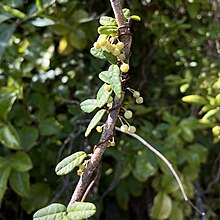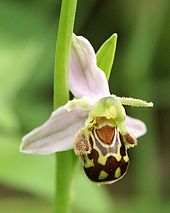利用者:Saico tan/sandbox/2
 |
ここはSaico tanさんの利用者サンドボックスです。編集を試したり下書きを置いておいたりするための場所であり、百科事典の記事ではありません。ただし、公開の場ですので、許諾されていない文章の転載はご遠慮ください。
登録利用者は自分用の利用者サンドボックスを作成できます(サンドボックスを作成する、解説)。 この利用者の下書き:User:Saico tan/sandbox その他のサンドボックス: 共用サンドボックス | モジュールサンドボックス 記事がある程度できあがったら、編集方針を確認して、新規ページを作成しましょう。 |

進化生物学において、植物における擬態とは、植物が他の生物に物理的または化学的に似て進化することで、擬態する生物のダーウイン適応度を高めることである。植物における擬態の研究は、動物における擬態に比べてはるかに少なく、文書化された事例や査読を受けた研究も少ない。しかし、擬態は草食から身を守ったり、送粉者のような共生種に、見返りを与えずにサービスを提供するよう欺く可能性がある[2]。
植物の擬態には、雌花が同種の雄花を模倣する「ベイカー型擬態(Bakerian mimicry)」や、蜜などの報酬を作る別の種の花や果実を模倣する「ドッドソン型擬態(Dodsonian mimicry)」、雑草が意図しない人為的な選択によって作物として利用される植物に似るように進化する「ヴァヴィロフ型擬態(Vavilovian mimicry)」、花が送粉者のメスの姿を模倣する「プーヤン型擬態(Pouyannian mimicry)」、無毒な種が有毒な種の特徴を模倣することで捕食を回避する「ベイツ型擬態(Batesian mimicry)」、草食動物の注意をそらすために近くにある別の植物の葉に擬態することなどが含まれる。
ベイカー型擬態
[編集]イギリスの博物学者ハーバート・G・ベイカーの名から命名された[3]ベイカー型擬態は、単一種の中で起こる「自己擬態」や「種内擬態」の一種である。植物におけるベイカー型擬態では、蜜などの送粉者にとっての報酬を持たない雌花が、同種の雄花を擬態することで、送粉者をだましている。この擬態は、中南米やアフリカの熱帯地域でみられるアブラナ目パパイア科の多くの種で一般的である[4][5]。パパイア科の植物は雄花と雌花の表現型が著しく異なっており(性的二形)、雄花は蜜を作るが雌花は作らない。ベイカーはこの植物が夕暮れ時にスズメガ科などの蛾の仲間によって訪花されていることを発見し、明かりの少ない時間にはこれらの植物の雄花と雌花は、送粉者にとって似通って見えていると結論づけた[6]。
ドッドソン型擬態
[編集]アメリカの植物学者Calaway H. Dodsonの名から命名されたドッドソン型擬態は、ベイカー型擬態と同じく繁殖のための擬態の一種だが、ベイカー型擬態とは異なり、擬態者とモデルが別種である[7]。モデルの花に似た形質を持つことで、ベイカー型擬態と同様に蜜などの報酬を作らずに送粉者を誘引することができる。
例
[編集]Epidendrum ibaguense, a species of epiphytic orchid of the genus Epidendrum that occurs in Trinidad, French Guiana, Venezuela, Colombia, and northern Brazil, resembles flowers of Lantana camara and Asclepias curassavica (commonly called Mexican butterfly weed, blood-flower, scarlet milkweed, or tropical milkweed), both are species of flowering plant with the first in the verbena family, while the latter belongs to the milkweed family, and both are native to the American tropics. Epidendrum ibaguense is pollinated by monarch butterfly (Danaus plexippus) and perhaps hummingbirds.[8] Similar cases are seen in some other species of the same family. The mimetic species may still have pollinators of its own though, for example a Lamellicorn beetle, which usually pollinates correspondingly colored Cistus flowers, is also known to aid in pollination of Ophrys species that are normally pollinated by bees.[9]
ヴァヴィロフ型擬態
[編集]ロシアの植物遺伝学者であるニコライ・ヴァヴィロフの名から命名された[10]ヴァヴィロフ型擬態(作物擬態(crop mimicry)や雑草擬態(weed mimicry)などとも呼ばれる[n 1])は、雑草が何世代にもわたる人為選択によって、作物として利用される植物と1つ以上の特徴を共有するように進化する、植物における擬態の一種である[11]。雑草に対する選択は、生えている雑草自体を殺すこと、雑草の種子を作物の種子から分離すること、またはその両方によって行われる。これは新石器時代から手作業で行われており、近年では農業機械によって行われている。
プーヤン型擬態
[編集]
Many plants have evolved to appear like other organisms, most commonly insects. This can have wide-ranging benefits including increasing pollination. In Pouyannian mimicry,[12] flowers mimic a potential female mate visually, but the key stimuli are often chemical and tactile.[13]
例
[編集]The hammer orchid (Drakaea spp., an endangered genus of orchid that is native to Australia) is one of the most notable examples. The orchid has both visual and olfactory mimics of a female wasp to lure males to both deposit and pick up pollen.[14][より良い情報源が必要]
The orchid Epipactis helleborine is physiologically and morphologically adapted to attract social wasps as their primary pollinators. Social wasps feed their larvae on insects like caterpillars. To locate that prey, they use a combination of visual and olfactory cues. The flowers of E. helleborine and E. purpurata emit green-leaf volatiles (GLVs), which are attractive to foragers of the social wasps Vespula germanica and V. vulgaris. Several E. helleborine GLVs that induced a response in the antennae of wasps were also emitted by cabbage leaves infested with caterpillars (Pieris brassicae), which are common prey items for wasps. Despite a large nectar reward, the species is almost entirely overlooked by other pollinators.[15]
Carrion flowers mimic the scent and appearance of rotting flesh to attract necrophagous (carrion-feeding) insects like flesh flies (Sarcophagidae), blowflies (Calliphoridae), house flies (Muscidae) and some beetles (e.g., Dermestidae and Silphidae) which search for dead animals to use as brood sites. The decaying smell of the flower comes from oligosulfides, decayed proteins that contain amino acids methionine and cysteine. While carrion flowers do produce a small amount of nectar, this does not necessarily make its relationship to necrophagous insects mutualistic. Insects lay eggs on the carrion flowers, meaning they mistake them for oviposition sites. The nectar acts as a lure to bring the insects closer to the reproductive parts of the flower.[16]
ベイツ型擬態
[編集]Template:Main articles In Batesian mimicry, named after the English naturalist Henry Walter Bates, a harmless species has evolved to imitate the warning signals of a harmful species directed at a predator.
例
[編集]Thorn mimicry of two types has been observed in plants. The first, a special case of intra-organismic Batesian mimicry characteristic of Aloe sp. (Liliaceae), W. filifera (Palmaceae), and dozens of species of Agave, including A. applanta, A. salmiana, and A. obscura. These plants develop thorn-like imprints or colorations on the face of their leaves due to the teeth along the margins of that leaf (or another leaf) pressing sustained indentations into the flesh of the non-spiny parts.
The second type of thorn mimicry, a more classic case of Batesian mimicry, involves the pointed, colorful organs like buds, leaves and fruit of memetic plant species that mimic aposematic colorful thorns not found anywhere else in the organism.[17]
Several plants growing in Israel, Estonia, Greece, and Japan exhibit possible spider web mimicry. Dense, white trichomes are produced on newly extended stems and leaves that deter herbivory due to predatory habit or toxicity. This may be a case of visual mimicry or perceptual exploitation. Case examples include the new buds of Onopordum from Israel, Carthamus sp. from Greece, flower heads of Arctium tomentosum from Estonia, a fledgling leaf of Tussilago farfara from Estonia, and new fronds of Osmunda japonica from Japan.[18]
Cryptic mimicry
[編集]In ecology, crypsis is an organism's ability to avoid detection by other organisms. Therefore, cryptic mimicry is a situation where a prey organism deceives a potential predator by providing false signals or a lack of signals. Cryptic mimicry in plants is usually achieved visually.
例
[編集]Boquila trifoliata, a South American member of the family Lardizabalaceae, is a climbing vine with a highly variable phenotype. It is capable of mimicking the leaf features of plant species that it clings to, adopting color shape and size. By camouflaging its leafy appendages, Boquila lowers its rate of herbivory.[1]
関連項目
[編集]脚注
[編集]注釈
[編集]- ^ この場合、擬態者が雑草であり、モデルがアリであるアリ擬態などとは異なる。
出典
[編集]- ^ a b Gianoli, Ernesto; Carrasco-Urra, Fernando (2014-05-05). “Leaf Mimicry in a Climbing Plant Protects against Herbivory”. Current Biology 24 (9): 984–987. doi:10.1016/j.cub.2014.03.010. PMID 24768053.
- ^ Pannell, John R.; Farmer, Edward E. (2016-09-12). “Mimicry in plants”. Current Biology 26 (17): R784–R785. doi:10.1016/j.cub.2016.04.005. PMID 27623255.
- ^ Barrett, S.C.H. (2001). “The Baker and Stebbins era comes to a close”. Evolution 55 (11): 2371–2374. doi:10.1554/0014-3820(2001)055[2371:tbasec]2.0.co;2.
- ^ Baker 1976, pp. 161–169.
- ^ Bawa 1980, pp. 467–474.
- ^ Spencer C. H. Barrett (1987). “Mimicry in Plants”. Scientific American 255 (9): 76-83.
- ^ Dodson & Frymire 1961, pp. 133–139.
- ^ Boyden 1980, pp. 135–136.
- ^ Kullenberg 1961, pp. 1–340.
- ^ Vavilov 1951, pp. 1–366.
- ^ Pasteur 1982, p. 169–199.
- ^ Pasteur 1982, p. 169.
- ^ van der Pijl & Dodson 1966, pp. 129–141.
- ^ Hammer Orchid and Wasps.
- ^ Brodmann, Jennifer; Twele, Robert; Francke, Wittko; Hölzler, Gerald; Zhang, Qing-He; Ayasse, Manfred (2008-05-20). “Orchids Mimic Green-Leaf Volatiles to Attract Prey-Hunting Wasps for Pollination”. Current Biology 18 (10): 740–744. doi:10.1016/j.cub.2008.04.040. PMID 18472423.
- ^ Johnson, Steven D. (2016-07-11). “Carrion flowers”. Current Biology 26 (13): R556–R558. doi:10.1016/j.cub.2015.07.047. PMID 27404246.
- ^ Lev-Yadun, Simcha (2003-09-21). “Weapon (thorn) automimicry and mimicry of aposematic colorful thorns in plants” (英語). Journal of Theoretical Biology 224 (2): 183–188. doi:10.1016/S0022-5193(03)00156-5. ISSN 0022-5193. PMID 12927525.
- ^ Yamazaki, Kazuo; Lev-Yadun, Simcha (2015-01-07). “Dense white trichome production by plants as possible mimicry of arthropod silk or fungal hyphae that deter herbivory” (英語). Journal of Theoretical Biology 364: 1–6. doi:10.1016/j.jtbi.2014.08.045. ISSN 0022-5193. PMID 25193285.
参考文献
[編集]- Baker, Herbert G. (1976). “"Mistake" pollination as a reproductive system with special reference to the Caricaceae”. In Burley, J. & Styles, B. T.. Tropical Trees: Variation, Breeding, and Conservation of Tropical Trees. London; New York: Academic Press for the Linnean Society of London. pp. 161–169. OCLC 2565215
- Bawa, K. S. (May 1980). “Mimicry of Male by Female Flowers and Intrasexual Competition for Pollinators in Jacaratia dolichaula (D. Smith) Woodson (Caricaceae)”. Evolution 34 (3): 467–474. doi:10.2307/2408216. ISSN 0014-3820. JSTOR 2408216. PMID 28568703.
- Boyden, Thomas C. (January 1980). “Floral Mimicry by Epidendrum ibaguense (Orchidaceae) in Panama”. Evolution 34 (1): 135–136. doi:10.2307/2408322. ISSN 0014-3820. JSTOR 2408322. PMID 28563205.
- Dodson, Calaway H.; Frymire, G. P. (1961). “Natural Pollination of Orchids”. Missouri Botanical Garden Bulletin 49 (9): 133–152. OCLC 604064774.
- Kullenberg, Bertil (1961). “Studies in Ophrys Pollination”. Zoologiska Bidrag Från Uppsala 34: 1–340. OCLC 7847789.
- Pasteur, George (1982). “A Classificatory Review of Mimicry Systems”. Annual Review of Ecology and Systematics 13: 169. doi:10.1146/annurev.es.13.110182.001125. ISSN 0066-4162.
- van der Pijl, Leendert; Dodson, Calaway H. (1966). “Chapter 11: Mimicry and Deception”. Orchid Flowers: Their Pollination and Evolution. Coral Gables: University of Miami Press. pp. 129–141. ISBN 978-0-87024-069-0. OCLC 310489511
- Vavilov, Nikolai I. (1951). Translated by K. S. Chester. “The Origin, Variation, Immunity, and Breeding of Cultivated Plants”. Chronica Botanica (13): 1–366. OCLC 608036378.
- Williamson, G. Bruce; Black, Edwin M. (April 1981). “Mimicry in Hummingbird-Pollinated Plants?”. Ecology 62 (2): 494–496. doi:10.2307/1936724. ISSN 0012-9658. JSTOR 1936724.
- “Sexual Encounters of the Floral Kind - 02 Hammer Orchid and Wasps”. YouTube. Template:Cite webの呼び出しエラー:引数 accessdate は必須です。
